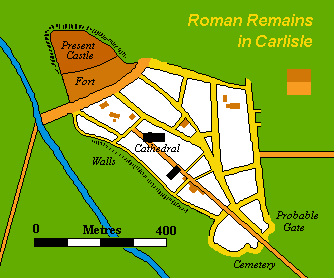
EBK Home
Kingdoms
Royalty
Saints
Pedigrees
Archaeology
King Arthur
Mail David
CARLISLE
The Northern Arthur's Camelot?
If Arthur was a King of the North as so many connections indicate, surely we should look for Camelot here too?
 Tradition:
Chrétien
De Troyes knew Carlisle as Carduel and stated it was in
Wales, presumably meaning the Welsh-speaking region of Britain. It was the
site of one of King Arthur's many palaces spread around the country. It
was at Carduel that Perceval (Peredyr)
first arrived at King Arthur's Court and, from here, Yvain (Owein)
set out on his grand adventure. Erec
(or Gereint)
also hoped to track Arthur down at either his court at Caduel or Robais.
Tradition:
Chrétien
De Troyes knew Carlisle as Carduel and stated it was in
Wales, presumably meaning the Welsh-speaking region of Britain. It was the
site of one of King Arthur's many palaces spread around the country. It
was at Carduel that Perceval (Peredyr)
first arrived at King Arthur's Court and, from here, Yvain (Owein)
set out on his grand adventure. Erec
(or Gereint)
also hoped to track Arthur down at either his court at Caduel or Robais.
Carlisle is similarly mentioned, via its modern name, by Sir Thomas Malory. Arthur received a Roman delegation there, and it was at Carlisle Castle that Medrod and Agravain discovered Lancelot and Gwenhwyfar in flagrante delicto. Lancelot escaped from the ensuing armed skirmish, but Gwenhwyfar remained to be sentenced to be burnt at the stake outside the city walls. Lancelot naturally returned to rescue her, but the resulting Wars enabled Medrod to seize the British throne and inevitably led to the fateful Battle of Camlann.
Early ballads concerning Gawain's unfortunate marriage to the "Loathly Lady" and his encounter with the spellbound giant "Carl of Carlisle" are also centred on the town and claim that:
King Arthur lives in
merry Carlisle,
And seemly is to see;
And there with him Queen Guenever,
That bride so bright of blee.
The Theory: Prof. Norma Lorre Goodrich in her detailed and imaginative study "King Arthur" uses many and varied arguments in an attempt to establish the High-King Arthur as a monarch entrenched in Northern Britain, particularly the Eastern Scottish border region. Leading on from this, she further suggests that Arthur's Camelot was the most recent Roman City to have been raised to the status of Tribal Capital: Luguvalium (Carlisle).
This appears to be based on the idea that the Caerleon of both Arthurian history and legend, was in fact merely a "City of the Legion" which should properly be identified with Carlisle. This is particularly indicated by Gildas' association of Saints Julius and Aaron with this latter city rather than, the more traditional, Caerleon. Added to this is a passage attached to some manuscripts of Nennius' Historia Brittonum which states that:
"Arthur translated into Latin is "Terrible Bear" or "Iron Mallet," which destroyed the Molae Leonum"
This latter phrase, Molae Leonum, is usually translated as "Lion's Teeth," presumably referring to the Saxon menace. Professor Goodrich, however, takes this to be Moles Llion which she translates as "Walls of the Waves". She suggests that this was an attempted translation of Caer-Ligualid, the British name for Carlisle, and that an alternative form would have been "Camelot" derived from Caer-Mallet or "Fort of the Hammerer," a name here recorded of Arthur.
Later Dark Age History: Bede recorded how St. Cuthbert visited Queen Iurminburg of Northumbria at a nunnery in Caer-Ligualid (Carlisle) in AD 685. The urban community there was controlled by a praepositus civitas. St. Cuthbert noted the city's high stone walls and commented on a most remarkable fountain, indicating a functioning aqueduct existed at this date.
Modern Archaeology: Carlisle Castle stands just to the North of the city on high ground on the site of a probable Roman fort, and possible Dark Age stronghold. Archaeological investigation has revealed that timber structures, possibly of the 5th century, replaced Roman stone buildings on the same alignment in Blackfrairs Street. These were later abandoned in favour of a large hall-like building which cut across them.
Possible Interpretations & Criticism: The Carduel identification of Carlisle appears to be quite sound, despite attempts to associate it with Caerleon. Carlisle was the Roman Luguvalium, later Caer-Ligualid before contracting to Carluel - no doubt the form from which Chrétien's Carduel was taken. Despite the confusion over which city was the home-town of the British proto-martyrs, there is no evidence to suppose that all records of Caerleon really refer to Carlisle; and the unfortunate late addition to Nennius is open to wide interpretation of which Professor Goodrich's is wholly unconvincing.
Caer-Ligualid (Carlisle) may well have become a major Dark Age City though, for it is closely associated with the historical 6th century King Urien of North Rheged. Both archaeology and historical records indicate a thriving Dark Age community, possibly within the walled area of the old fort. It is possible that the town became an early Bishopric which survived the Anglo-Saxon transition. There are strong indications that St. Patrick's family held positions in the Church nearby. Memories of these past glories may have led to medieval Arthurian associations.
